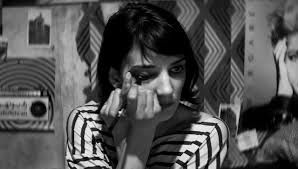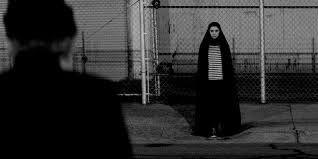
Although horror films traditionally present women as victims, the genre allows female protagonists to emerge victorious. They are the ones who face down the monster and deliver the killer blow, be it Ripley in the Alien movies or Sidney in Scream and its sequels. Heroines are vindicated for their lifestyle choices - for not being trivial or frivolous. There is no happy ending for them, just calm - sleep. But when the female protagonist is the monster, what comfort is offered to the audience? Can we identify with the ‘monster’ and revel in their actions? Or do these films ask us to acknowledge female power and hope that it is exercised responsibly?
A Girl Walks Home Alone At Night isn’t just a female vampire movie – it is in the Farsi language. Its writer-director Ana Lily Amirpour is Iranian born, but her film is not Iranian. For starters, it has zero chance of commercial distribution in her native county. Even if the violence committed by the ‘girl’ of the title could be overlooked, the brief bathtub scene showing female nudity cannot. Characters represent a certain Middle Eastern mindset – westernised in some aspects (going to parties, cultivating bling) – but traditional in others, venerating the father.
The setting is identified as Bad City, but it could be any Texan border town. Its male hero, Anash, is first seen hanging around a barn or coop. He disappears into it and emerges with a cat. Traditionally, women are cat people. We wonder if Anash has acquired the cat as a gift or possibly to sell on. There aren’t many businesses in Bad City. A small boy asks Anash for money – he refuses.
Anash’s father is an addict, holed up at home waiting for his next fix. He also owes money. His debtor, a local gangster with a facial tattoo in Arabic on the side of his face and neck tattooed with the English word ‘sex’ on his neck comes to collect and takes Anash’s car keys as payment. Anash slams his arm against the wall in frustration, injuring it – his forearm is in bandages and later in plaster throughout the rest of the movie.
The gangster has a girl, possibly a prostitute, who wants her share. He refuses. At night he picks up a girl in a head scarf (Sheila Vand). He takes her back to his place, snorts a few lines. She attacks him; her fangs make the sound of the ring of a beer can being pulled, like popping a tab. It is clear that gangsters are fair game.
The vampire stalks the prostitute, copying her every move. She follows the young boy seen earlier, asking him repeatedly ‘are you good?’ She is an enforcer of morality – of good behaviour. She runs into Anash after he attends a costume party dressed as Dracula and we fear for his life. He has taken a pill that affects his consciousness; he wants to sit down. The vampire makes accommodating use of the skateboard that she acquired from the young boy.
The film, presented in black and white, is atmospheric. We see mining machinery at work, the motion of the pumping equipment reminding us of the downward trajectory of a vampire’s fangs. So there is a parallel between drilling for oil and drawing blood. This comparison naturalises the vampire as a living extension of business, sucking life above the Earth as machines deplete natural oil reserves from below it. The parallel isn’t developed but it presents the vampire as a fait accompli, a force that has to be accepted.There is a contrast. Oil wealth is the fuel of Middle Eastern decadence; the vampire is subversive.
We know from vampire lore that blood sucking is a necessary evil, that vampires cannot live without quenching their thirst. So for the girl to have any sort of lasting relationship with a human she has to suppress her hunger. Our familiarity with the genre makes us sceptical – you cannot give up what you need to survive.
Anash has to be liberated from his ties to the city. Then he can leave.The ending is that of a traditional monster movie, consigning horror to the rear view mirror. The girl arguably carries out a mercy killing. She also attacks a transient. At no point does she face religion, traditionally the oppositional force to a vampire – order confronting decadence. The argument is that in Bad City, a vampire can thrive easily on bad people.
The girl doesn’t say much, but does things like other young women – take a bath and apply make-up. She isn’t shown yearning for something, but her interactions with Anash suggest that she might want a companion, someone like her.
Amirpour’s film doesn’t focus on the big confrontation between the vampire and its nemesis. Rather it gets that out of the way early on. This film isn’t about morality being reinforced by the elimination of a counter-force. It is about reconfiguring the space, reshaping society. This is what the final scene represents – a journey into the unknown. To make this point, Amirpour needs the fantasy genre as a space in which women can assert their role in a new society, eliminating all bad influences. The finale isn’t about Iran, but the world for women.

Reviewed on home DVD, Friday November 13, 2015 – on the evening in which terrorists struck at seven locations in central Paris, killing over a hundred, but not defeating the heart of a city and its people



